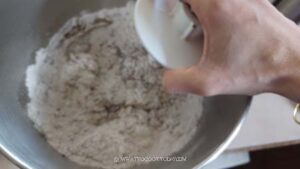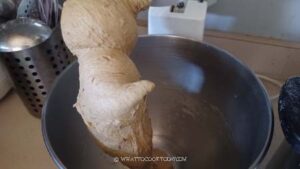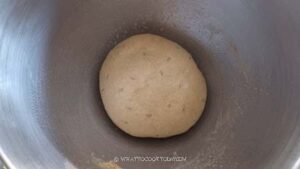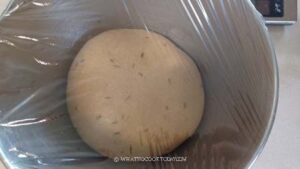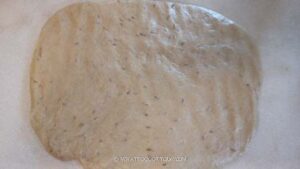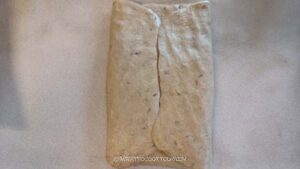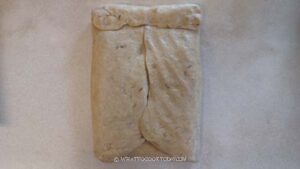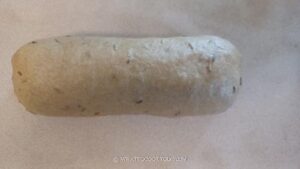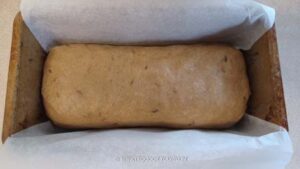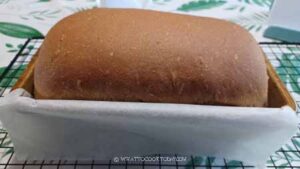This post may contain affiliate links. Please read our disclosure policy.
This soft rye sandwich bread is fluffy, flavorful, and easy to make. They are perfect for sandwiches, toast, or just with butter.
I’ve never baked bread with rye until about three years ago when I started baking sourdough bread, and honestly—I was hooked right away. Rye has this earthy depth and a subtle hint of sweetness that makes it so unique. This soft rye sandwich bread is one of my favorite ways to enjoy rye flour without going full sourdough. It’s tender, fluffy, and slices beautifully, making it perfect for sandwiches or just enjoying with a good smear of butter.

A Little Background on Rye Flour and Rye Bread
Rye has been grown and enjoyed for thousands of years, especially in Northern and Eastern Europe, where the cooler climate made it tough to grow wheat. That’s why rye bread became a staple in places like Germany, Poland, Russia, and Scandinavia.
Rye flour contains less gluten than wheat flour, which means breads made entirely from rye are often denser and darker, with a deep, earthy flavor. By combining rye flour with bread flour, you get the best of both worlds—the flavor and character of rye, but with a softer, fluffier texture that’s perfect for everyday sandwich bread. A little molasses adds sweetness and moisture, while caraway seeds bring that unmistakable aroma of traditional rye bread you might remember from delis or old-world bakeries.
Why You’ll Like This Recipe
- The bread is soft and fluffy with just enough structure to hold sandwich fillings.
- The combination of rye flour, molasses, and caraway seeds gives it a nostalgic old-world bakery flavor.
- It’s beginner-friendly: no tricky techniques, just proof, shape, and bake.
- Works with a stand mixer, eliminating the need for heavy kneading by hand.
- Stores well and tastes even better toasted the next day.
Ingredients and Substitutions
- Bread flour – Use a strong flour with at least 12% protein for proper gluten development. You can substitute with all-purpose flour (lower protein), but the bread will be slightly less chewy and lower rise.
- Medium rye flour – Adds that earthy, nutty rye flavor. You can use light rye flour for a milder taste or dark rye flour for a deeper, more intense flavor.
- Instant yeast – I recommend instant yeast for ease, but you can use active dry yeast (1 ½ tsp). If using active dry, dissolve it in warm milk (from the recipe) and let it bloom for 5 minutes before adding.
- Salt – Essential for flavor balance.
- Oil – Neutral oil like canola, avocado, or light olive oil. Melted butter also works and will give a richer taste.
- Molasses – Adds sweetness, moisture, and a deep, slightly smoky flavor. You can substitute with honey or dark brown sugar, but the flavor will be different.
- Caraway seeds – Classic in rye bread! If you don’t like caraway, leave it out or swap with fennel seeds for a gentler flavor.
- Milk – Provides moisture and softness. Whole milk will yield a richer crumb, while non-dairy milk (such as soy, oat, or almond) is an option if you prefer a dairy-free alternative.

Frequently Asked Questions
- Why is my rye dough sticky?
Rye flour has less gluten, which makes the dough stickier than wheat doughs. This is normal—avoid adding extra flour or the bread will turn dense. - Can I make this bread without molasses?
Yes. You can use honey, maple syrup, or dark brown sugar. The bread will be slightly sweeter and less earthy. - How do I know the bread is done baking?
Use a thermometer: the internal temperature should be at least 190°F (88°C). The loaf should sound hollow when tapped on the bottom. - Can I knead by hand instead of a mixer?
Yes, but expect it to be very sticky. Use a bench scraper and resist the urge to add flour. Knead for about 10–12 minutes until elastic. It’s not easy to do it by hand, but if you are up for a challenge, go for it. - Can I freeze this rye sandwich bread?
Absolutely. Once cooled completely, slice and wrap tightly in plastic wrap or foil. Place in a freezer bag and freeze for up to 1 month. Thaw at room temperature or toast straight from frozen.
Homemade rye bread always feels like a little trip back in time. It’s comforting, earthy, and so versatile. This soft rye sandwich bread is one of those recipes that doesn’t ask too much of you, but rewards you with slices of warm, flavorful bread that are perfect for sandwiches, toast, or just with butter.

Soft Rye Sandwich Bread
Ingredients
- 250 g bread flour (12.7% protein content)
- 110 g medium rye flour
- 1 ¼ tsp instant yeast
- 1 tsp salt
- 45 g oil
- 43 g molasses
- 17 g caraway seeds
- 198 g milk I use 2% milk, more as needed
Instructions
Prepare the dough:
- Put all the ingredients in a mixing bowl of a standmixer fitted with a dough hook attachment. Stir it a bit to roughly combined the wet and dry ingredients

- Start the machine on the low speed to mix everything until you don't see dry ingredients. Stop the machine, cover the bowl and let it sit for 20 minutes. This part is so that the flour has time to get hydrated and is easier to be kneaded

- Uncover the bowl and start the machine on a medium speed and knead for about 6-7 minutes or until the dough is smooth and elastic. The dough is sticky because rye flour can make the dough sticky. This is normal. Don't try to add more flour. As long as it is smooth and elastic, you are done kneading.

First proofing:
- Lightly oil your hands. Remove the dough from the bowl with the help of a dough scraper. Round it up into a dough ball. Spray the bowl with some oil and put the dough back in, cover, and let it rise in a warm place until it is puffy.

- It may not be doubled, but it should be puffy. This may take somewhere around 1-2 hours

Shape the dough:
- Oil a 8 1/2 x 4 1/2 loaf pan. I line with parchment paper on a long side. You can also use 9 x 5 loaf pan. The loaf will be wider and shorter
- Deflate the dough to remove air bubbles and round it up. Cover and let it rest for about 5 minutes to relax the dough
- Flatten the dough into a rectangle, the length a bit shy of the length of the loaf pan.

- Fold the two sides to meet at the center and then roll the dough into a log.

- Then roll the dough down to form a log


- Place this inside the prepared loaf pan.

Second proofing:
- Covered with a lightly oiled cling wrap and let it rise again until it reaches about 1-inch above the rim if you use 8 1/2 x 4 1/2 inch loaf pan. If you use 9 x 5-inch loaf pan, it should rise about the same level as the rim. This may take about 45 minutes to an hour or longer, depending on the temperature

Baking:
- 15 minutes before the end of the second proofing, preheat the oven to 350 F (180 C) for conventional oven. For convection oven, lower the temperature by 20 F/15 C. Position the rack in the middle of the oven
- Bake the bread for 40-45 minutes if you use 8 1/2 x 4 1/2 inch loaf pan and about 35-40 minutes if you use 9 x 5 inch loaf pan. The internal temperature should be at least 190 F ( 88 C)
Cool down:
- Let the bread cool down in the pan for about 5 minutes and then lift it out from the pan and peel the parchment paper away and let it cool down completely on a cooling rack. DO NOT slice into a warm bread.

